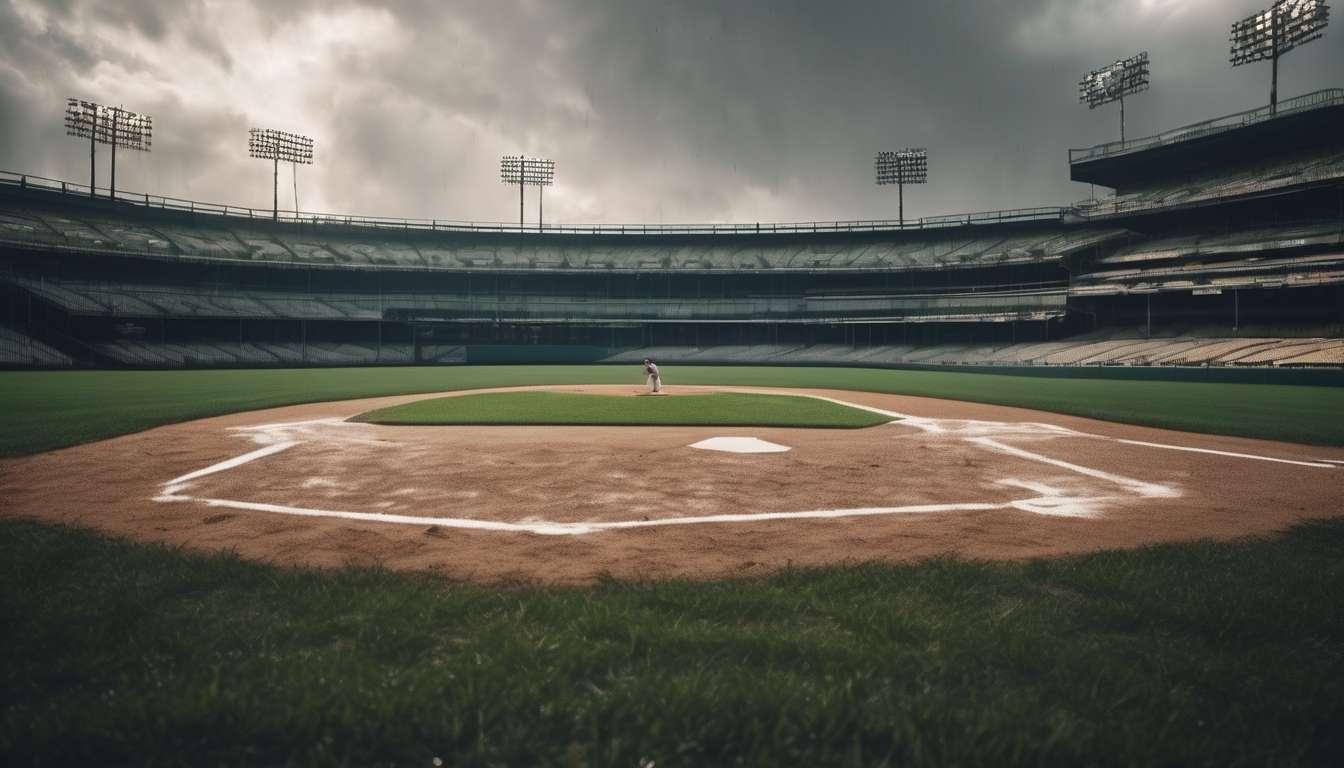As avid baseball enthusiasts, we have always been captivated by the intricate dynamics of Major League Baseball (MLB) games. Yet, one element often overlooked by fans and analysts alike is the profound impact of weather on game outcomes.
Together, we embark on an exploration of how varying weather conditions shape the performance of teams and players alike. By delving into evidence-based studies and statistical analyses, we aim to unravel the nuanced ways in which:
- Temperature influences batting averages.
- Wind affects pitching precision.
- Precipitation impacts fielding effectiveness.
Our journey will shed light on the subtle yet significant role that Mother Nature plays in the sport we love. Whether it’s the sweltering heat of a midsummer afternoon or the crisp chill of an autumn evening, we’ll uncover how these atmospheric variables contribute to the ebb and flow of the season.
Join us as we reveal how weather is an unsung player in every MLB game.
Batting Averages and Temperature
Many studies show that higher temperatures can lead to increased batting averages in MLB games. As fans who crave the thrill of a well-played match, we know that the weather can heighten the excitement on the field. When temperatures rise, baseballs tend to carry further, potentially turning routine fly balls into home runs. This phenomenon can electrify the atmosphere in the stadium, connecting us all in shared anticipation.
Let’s consider how temperature, wind, and precipitation work together to shape these dynamics.
- Warmer air is less dense, allowing balls to travel farther, which can boost our team’s chances at the plate.
- While wind plays a role too, impacting the ball’s trajectory, we’re focusing on how the heat of a summer day can give hitters an edge.
- Precipitation, on the other hand, can dampen our spirits and the game, often leading to delays.
But when the sun shines and temperatures soar, we feel a collective energy, ready to cheer our team to victory.
Wind and Pitching Precision
We all know that even a slight breeze can influence a pitcher’s accuracy, altering the path of the ball in unexpected ways. When we gather at the ballpark, we share in the anticipation, knowing that wind can be the hidden player, affecting every pitch.
Wind direction and speed can shift a well-aimed fastball, causing it to veer off course. We’ve seen pitchers adjust their grips and stances to counteract these invisible gusts. It’s a game of strategy as much as skill, and we’re all part of it.
Temperature also plays a role:
- On warmer days, the ball travels differently, impacting control.
- Cooler temperatures might tighten muscles, making precision more challenging.
Add precipitation into the mix, and the complexity grows. While precipitation mainly affects fielders, it can also make the ball slippery for pitchers, requiring them to focus even more on their technique.
We’re all in this together, feeling the shifts in weather and its impact on our beloved game.
Fielding Effectiveness and Precipitation
Every time raindrops fall on the field, fielders adjust their strategies to maintain their effectiveness amidst challenging conditions. Precipitation can turn a routine play into a test of skill and adaptability. The slick surface demands precision, where even the slightest misstep can lead to costly errors.
As part of a community that cherishes the essence of baseball, we understand the importance of each fielder’s response to these elements.
Temperature and wind further complicate matters:
- A cooler day might seem favorable, but when paired with precipitation, it can reduce grip and agility.
- Wind plays tricks with the ball’s trajectory, making every catch an unpredictable challenge.
Together, these elements require fielders to be not just athletes but also strategists, ready to adapt to the ever-changing conditions.
As we’ve seen time and again, it’s this adaptability that binds us together, as we root for those who rise to the occasion.
The Impact of Humidity on Players
Humidity can significantly affect a player’s performance by influencing their stamina and grip on the equipment. When considering playing conditions, many focus on temperature, wind, and precipitation, but humidity is equally crucial.
Effects of High Humidity:
- High humidity can make the air feel heavier, sapping energy as players engage in physical activity.
- It’s not just about the temperature; it’s about how the moisture in the air interacts with the body.
Challenges Posed by Rising Humidity:
-
Increased Sweating:
- Players often sweat more, which can lead to dehydration if not managed properly.
- Dehydration affects stamina, making it challenging to maintain peak performance.
-
Grip Issues:
- Sweaty hands might lead to a weaker grip on equipment like bats or balls, impacting overall gameplay.
Strategies for Adaptation:
-
Hydration Strategies:
- Teams should prepare with effective hydration plans to combat the effects of increased sweating.
-
Equipment Adjustments:
- Adjustments may be necessary to ensure players maintain their grip and control over equipment.
By understanding and anticipating these weather effects, we strengthen our community and enhance our performance, ready to tackle any challenge together.
Weather’s Influence on Home Runs
Several weather factors play a crucial role in determining the frequency and distance of home runs in Major League Baseball. As fans, we’re all in this together, witnessing how temperature, wind, and precipitation can alter the game we love.
Temperature:
- Higher temperatures often lead to balls traveling further.
- Warm air is less dense, providing less resistance.
- We’ve all seen those summer night games where the ball just seems to fly.
Wind:
- A strong tailwind can turn a routine fly ball into a home run.
- Conversely, a headwind might keep the ball inside the park.
- We can feel the tension in the stands, waiting to see which way the wind will sway the outcome.
Precipitation:
- Wet conditions can make the ball heavier and harder to hit with power.
Together, these elements create a dynamic playing field, adding excitement and unpredictability to every pitch.
Temperature Swings and Player Performance
We often notice how drastic temperature swings can challenge players’ adaptability and performance on the field. As a community passionate about the game, we know that temperature isn’t just a number; it’s a game-changer.
-
When temperatures drop:
- Muscles tighten, potentially increasing injury risks.
- A player’s ability to perform at their peak can be affected.
-
Conversely, high temperatures can lead to:
- Fatigue and dehydration.
- Sapping of energy and focus.
Wind, often accompanying these temperature changes, adds another layer of complexity.
-
A strong breeze can:
- Alter the ball’s trajectory.
- Force players to adjust their timing and strategy.
-
Even slight precipitation can:
- Make the field slippery.
- Affect grip and footing, directly influencing the outcome of a game.
Embracing these challenges together, we find that players must exhibit resilience and adaptability, qualities we admire and celebrate.
In understanding these weather impacts, we connect deeper with the sport, appreciating every pitch, swing, and catch in a new light.
Rain Delays and Game Strategies
Rain delays can disrupt the rhythm of a game, forcing teams to quickly adapt their strategies to maintain their competitive edge.
We know the feeling of anticipation as we wait for the skies to clear, sharing that collective moment with fellow fans. Behind the scenes, managers and coaches are busy recalibrating, considering how precipitation affects the field conditions and player performance.
- Our pitchers might need to adjust their grip.
- Hitters must adapt to changes in temperature and wind, which can alter ball trajectory.
When rain interrupts play, it’s not just an inconvenience; it’s an opportunity for strategic recalibration.
Teams might decide to:
- Shuffle their bullpen.
- Rest key players longer.
This allows them to use the delay to their advantage. We find ourselves analyzing these decisions, feeling that connection to the game and each other.
As fans, understanding these dynamics deepens our appreciation for the sport, reinforcing our sense of belonging within the baseball community.
Together, we embrace the unpredictability of weather and its impact on the game.
Weather Trends and Seasonal Patterns
Every season, we witness how evolving weather patterns influence the dynamics of Major League Baseball games. As avid fans and part of a community that thrives on the sport’s nuances, we understand that temperature, wind, and precipitation are not just background details—they’re integral to the game’s outcome.
Temperature Effects:
- When temperatures rise, the ball tends to carry farther, delighting us with more home runs.
- Conversely, cooler temperatures might dampen that excitement, favoring pitchers over batters.
Wind as a Wild Card:
- A strong wind blowing out to center field can turn a would-be flyout into a thrilling home run.
- In contrast, a gust blowing in might save a pitcher from a damaging hit.
Precipitation Challenges:
- Precipitation, though often seen as a nuisance, plays its part by leading to game delays and creating slippery fields, testing both players’ skills and our patience.
Through each season’s unique weather challenges, we bond over our shared passion for baseball.
How does weather affect the attendance and atmosphere at MLB games?
Weather significantly impacts the attendance and atmosphere at MLB games.
Rain or extreme heat can deter fans from coming to the ballpark, leading to lower attendance numbers.
On the other hand, clear skies and pleasant temperatures tend to draw larger crowds, creating a more vibrant and energetic atmosphere in the stadium.
Overall, weather plays a crucial role in shaping the overall experience for fans and players alike during MLB games.
Are there specific stadiums more affected by weather conditions than others due to their location or design?
Certain stadiums are indeed more impacted by weather conditions. Factors like location and design play a significant role.
For instance, open-air stadiums in colder regions may see attendance drop during inclement weather. Conversely, indoor stadiums can provide a more consistent experience for fans regardless of weather.
Understanding these nuances can help teams strategize and adapt to maximize fan engagement and overall game experience.
Teams can focus on the following strategies:
-
Location Analysis
- Assess the typical weather patterns in the area.
- Consider the impact of seasonal changes on attendance.
-
Stadium Design
- Opt for retractable roofs to offer flexibility.
- Enhance heating or cooling systems to maintain comfort.
-
Fan Engagement
- Provide weather-related amenities such as blankets or cooling fans.
- Offer incentives for attending games in less favorable conditions.
By addressing these factors, teams can better prepare for and mitigate the effects of weather on game attendance and fan satisfaction.
How do teams prepare for adverse weather conditions before a game?
Before a game, our teams focus on preparing for adverse weather conditions by:
- Monitoring forecasts
- Adjusting strategies accordingly
We ensure that players have appropriate gear for potential rain, wind, or extreme temperatures.
Additionally, our coaching staff works closely with meteorologists to stay informed about any weather changes that could impact the game.
Overall, our goal is to be proactive and ready to adapt to whatever conditions may arise on game day.
Conclusion
In conclusion, weather plays a significant role in shaping MLB outcomes.
Various weather elements influence player performance and game strategies:
- Batting averages can be affected by temperature.
- Wind impacts pitching precision.
Understanding these weather-related factors can provide teams with a competitive edge and help players adapt to changing conditions.
Keep a close eye on the forecast to stay ahead in the game.




